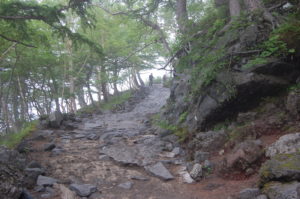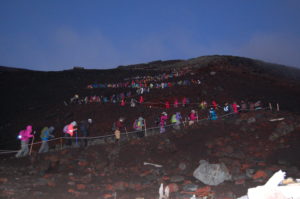I think the idea of climbing Mount Fuji hatched in the Admiral’s brain a couple of years ago. We were riding the bullet train and for the first time ever, he could see Mount Fuji in the distance. It’s usually shrouded in low clouds. I could practically hear the gears in his head shift into overdrive from across the aisle. Actually, it was supposed to be my nephew, Chris, who accompanied my dad up the mountain, but through a series of events, I replaced him. I at first had declined participating, I’m not sure why….. Then I climbed Mount Kilimanjaro with the Survivor Summit team that included dad and daughter, Bob and Maddie. Seeing their shared experience and how much it meant, especially to Bob, made me circle back around. I told the Admiral that I’d go with him and Chris; then Chris tore his ACL. Good thing for my dad that I was already onboard, because even though he is the admiral-in-charge, Pally laid down the law that he would not climb solo.
We arrived at the 5th Station of Mount Fuji around 9 in the morning. It’s at about 6000 feet. We planned to climb to about 11,000 feet, just past the 8 1/2 Station, where we’d sleep for a few hours, then summit and descend. It’s less than 4 miles to our stopping point, so that sounded reasonable. The Admiral wanted to go slowly as his knee and hip had been bugging him, so he figured 6 hours up. The day was overcast, so the temperature was perfect. That’s when my dad casually mentioned that the average grade of the trail is 21-percent. Whaat? Ok, steep. But also crazy rocky and lots of volcanic rock and ash which made forward progress slow.
Some of the hike was hands and feet over big boulders of volcanic rock, as you can see. The altitude was really starting to take a toll on the Admiral after a while. After a few hours, he resorted to the “50 steps then take a break” plan of attack, which is ironic, because I usually resort to counting steps during the marathon portion of an Ironman. Maybe we share the genetic bail-out gene.
After a couple of miles, there are mountain houses, I think 17 of them, before we get to Fujisan “Hotel,” where we’d be staying for the night. All of the houses have little restaurants, stores, and dorm-like sleeping areas.
We had noodles and rice at one of the stops…. rested at most of them… and were dismayed to see how steep the ascent was when we walked around the corner of the buildings. By now, we were going very slowly, resting often because of the steep and sketchy terrain and the lack of Oxygen. But we met lots of really nice people along the way, including a guy who was in the Navy and his wife who’d just moved to Japan. We finally got to Fujisan Hotel around 5 or 5:30. That’s more than 8 hours of moving, which is A LOT. Anyway, after checking in, we got our hot dinner, which for me was rice and stewed hot vegetables. Coincidentally, that nice couple was staying at the Fujisan and ate dinner with us. Even more coincidentally, their sleeping areas were right next to ours.
The sleeping arrangements were long rows of wooden pallets with sleeping bags laid out side by side. Your area was the size of a sleeping bag, no more. You hung your backpack on a hook over your head (over my feet, as I decided to sleep upside down so my face wasn’t 8 inches away from the Navy dude’s head or my dad’s head). Your hiking boots went under the pallet. It was tight. Our sleeping area was on the second floor, but the bathroom was on the first floor. That was a bad thing, as I was over hydrated and had taken Diamox, which protects against altitude sickness but also is a diuretic. It cost 200 yen (about $2) to use the restroom. I spent 1,000 yen, TEN DOLLARS, peeing overnight.
Once I woke up and all the sleeping bags around me were empty. My dad and the Navy couple were all gone. I went downstairs to spend another 200 yen in the bathroom and found all of them doing Oxygen shots and drinking Pocari Sweat (an unfortunately named sports drink in Japan). Sleeping at 11,000 feet is tougher for folks who live at sea level than it is for folks like me who live at 7,000 feet. I missed the party, but later, the Admiral filled me in on the conversation. Turns out they know several of the same people in the Navy. Small world.
We got up at 2:30 am. People were already headed up to the summit, hoping to be there by sunrise. Our breakfast was, surprise! rice and pickled cold vegetables. We headed out to the summit in the dark with headlamps and wearing every piece of clothing we brought. It was really cold and damp, and WINDY, but clear for the first time. It’s a little over a mile to the summit. The sun was going to come up around 4:30 or so, but we would see it come up whether or not we got to the top. The going was even slower now. There was a lot of stop and go. Trying to pick our way through the rock in the dark was treacherous. My dad has really improved his fitness, dropped a lot of weight, and was trained for the physical part of the journey. But as I learned on my Kili climb, there’s not much you can do to prepare for the altitude. He was suffering, and I have to admit I was a little concerned with how hard he was breathing and how often he stopped and sat. But he kept saying, “I know I’m going to make it now,” and onward and upward we went.
Then, the sky started to lighten and we stopped to watch as the sun crept up into the sky. First, we heard cheering and applause from higher up the mountain, then we saw this:
The beauty of it made you forget you were sore, tired, or cold. It recharged us and pushed us the last few hundred meters toward the summit. Slowly. Everyone in front of us had stopped to watch the sun rise, too, so this is what we had to negotiate. It’s actually one of my favorite pictures from the climb.
We were happy to get to the summit around 6. Unfortunately, the post office and store that are there (supposedly) were closed because it was too early. There were gale-force winds and I was so cold I couldn’t feel my fingers or toes, so we only stayed long enough to take a few photos.
The descent was gnarly. Steep and slippy, and we ran out of water. Unbelievably, there are 17 places to buy water on the way up Mt Fuji and NONE on the way down. It was kind of a Catch 22: We were slow so we needed more water and because we didn’t have any water, we were probably slower. Our descent didn’t take much less time than our ascent which made for a pretty miserable mid-morning. When we were reasonably close to the 5th Station again (almost to the area where they have pony rides for the kids… I think I about had the Admiral ready to ride a pony down the last couple hundred meters. I would have paid a lot of yen to see that), I ran down and got water and brought it back to the Admiral. He had apparently rallied and, Thank God, I didn’t have to go very far back up the mountain.
The Admiral says it was the toughest thing he’s ever done. I’m sure that’s true, but I never had any doubt he’d do it. He has been training for months for this and he’s more stubborn than I am. Oh, and I should mention that he’s 75 years old. 75! I figure that means I can expect to have epic adventures like this for another 20 years. Life is good.









Congratulations to you and the admiral for making the climb! Truly a great achievement and thank you for sharing your experiences.
I am tackling Fujisan next year and was wondering whether you could answer one question. Are there any sections on the trail that can be considered dangerous? That is, areas where one mistep could mean you tumble down steep sections of the mountain and really hurt yourself?
Thank you for your advice in advance.
Cheers, Tom
Hi Tom!
There are long parts that are a bit treacherous… rocky, steep, loose gravel. You could for sure hurt yourself if you’re not careful, but you won’t fall far. 🙂 Hope that’s helpful. w